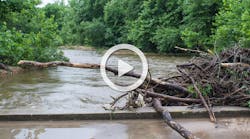UV CIPP expands toolbox for addressing environmentally complex sewer rehabilitation
Traditional cured-in-place-pipe (CIPP) lining is one of the most widely used pipe rehabilitation methods, as it is a cost-effective, minimally disruptive alternative to total pipe replacement. Traditional CIPP not only reduces costs but also offers a broad diameter installation range and wide choice of liners and resins. As installation requirements become increasingly diverse and incorporate environmental considerations, the industry is seeing new CIPP curing methods, such as UV CIPP, emerge to provide contractors, engineers and asset owners new options to customize a repair for a project’s unique specifications.
Ideal Areas for UV CIPP
Styrene-related odor emissions can be a concern for environmentally sensitive locations, such as schools or hospitals. In certain regions, especially in the Northeast United States, residential drains are connected directly to sewer mains, which means styrene off-gassing could also be a concern for those communities at large.
When utilizing UV CIPP, a UV liner such as the EnviroCure ®V is pre-impregnated with resin before it reaches the project site, which helps alleviate any styrene off-gassing concerns. Not only is the resin completely encapsulated within the liner, but the liner’s multilayer combination of felt and fiberglass provides a corrosion-resistant barrier with high physical strength resulting in a thinner pipe wall design than traditional CIPP. Additionally, an outer foil protects against UV light contamination.
Data & Detection Made Easy
UV CIPP curing relies on the use of UV lights mounted on a “light train” and pulled through the UV liner to ensure a consistent cure. Using sophisticated UV curing technology, the curing process is fully monitored with infrared sensors that capture data from every foot along the pipe. The data, stored in the UV curing system’s on-board computer, provides the installer and the asset owner with real-time and post-project reporting that becomes part of the installation record. This data can be especially useful for complicated projects with significant regulatory interest, such as those under consent decrees. Upon completion, it is easy to verify the resin is fully cured before putting the pipe into service.
Contractors Benefit from Expanded CIPP Options
As environmental concerns move up legislative and community agendas, potentially affecting project specifications for engineers and municipalities, the ability to provide a solution that is both environmentally friendly and accommodates a broad range of pipe diameters becomes increasingly important. Expanding trenchless rehabilitation options available for projects helps contractors to be prepared for any project requirement, giving asset owners confidence in the rehabilitation work, and avoiding call-backs. UV CIPP is a valuable extension of existing CIPP capabilities and expands contractors’ options which can be especially useful when environmental specifications are included in rehabilitation projects.
Maine Municipality Successfully Repairs Sewer System with UV CIPP
A sanitary sewer system more than 100 years old in Maine required repair. Made of vitrified clay pipe (VCP), the sewer system was originally laid in three-foot sections, and the high number of pipe joints made the system prone to cracking, leaks, root infiltration and misalignment. Correcting these issues was complicated, as the sewer system connected directly to residents’ homes — a common occurrence in the region — and any repairs would directly affect individual homes as well as the entire community.
The municipality chose to install a UV CIPP liner for its high strength, durability and styrene encapsulation. After the pipe was cleaned, a pre-inspection was performed. An EnviroCure UV Liner was installed and cured, and service laterals were reinstated. A post-installation inspection was also performed. The 285-foot section of pipe was fully rehabilitated and reinstated in just eight hours. The municipality achieved full restoration of its sewer system’s integrity without sacrificing flow, and while accommodating the environmental requirements the project demanded.
Planning for Trenchless Repairs as Environmental Regulations Grow
For trenchless pipe repair and rehabilitation, there is no one-size-fits-all solution. As environmental considerations grow and regulations potentially become more stringent, it is important to have several options to offer asset owners. UV CIPP is a worthy addition to contractors’ toolboxes as it expands contractors’ CIPP capabilities to ensure they can perform trenchless repair for a broader range of requirements. UV CIPP also helps expand contractors’ workload as it can be used in cold or hot temperatures. This proven approach maximizes installation flexibility to deliver long-lasting, corrosion and leak-free performance.
Wesley Kingery is Chief Operating Officer for Vortex Companies. In this role, he leads the cross-collaboration strategy between the company’s Services and Products divisions to strengthen customer relationships, increase sales and improve overall service and product quality. The company he co-founded, VacVision Environmental, was acquired by Vortex in 2017.
About the Author
Wesley Kingery
Wesley Kingery is Chief Operating Officer of Vortex Companies.


